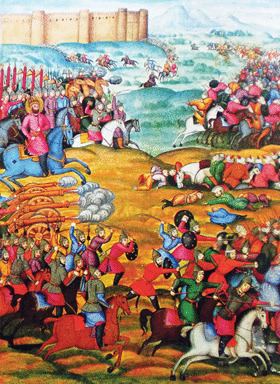Unknown 60,000+ Location Central Asia | minimal heavy | |
 | ||
Results Decisive Persian victory, (the conquest of the Central Asian khanates) Similar Nader's Sindh Expedition, Western Persia campaign, Nader's Mesopotamian Campaign, Battle of Khwar Pass, Battle of Zarghan | ||
Nader s central asian campaign
During the mid-eighteenth century the Persian empire of Nader Shah embarked upon the conquest and annexation of the Khanates of Bukhara and Khiva . The initial engagements were fought in the late 1730s by Nader Shah's son and viceroy Reza Qoli Mirza who gained a few notable victories in this theatre while Nader was still invading India to the south. Reza Qoli's invasions of Khiva angered Ilbars khan, the leader of Khiva. When Ilbars threatened to make a counter-attack Nader ordered hostilities to cease despite his son's successes and later returned victoriously from Delhi to embark on a decisive campaign himself.
Contents
- Nader s central asian campaign
- The conquest of Bukhara
- The battle of Petnak
- Khanates revolt against Persian Imperium
- References
After annexing Khiva he executed Ilbars and replaced him with Abu ol-Fayz Kha, who Nader considered to be more accepting of Nader's overlordship. The conflict resulted in the most overwhelming Persian triumph against the khanates of Central Asia in modern history and with the admixture of his previous annexation in northern India, Nader's empire in the east surpassed all other Iranian empires before it, all the way back to the Sassanians and Achaemenids of antiquity.
The conquest of Bukhara
In 1734-35 Ilbārs Khan sent a large party of Turkmens in a raid against Khorasan, where they plundered Čamešgezek Kurds in the regions of the Ālā Dāḡ mountain and Samalqān, but then were defeated by the Persian army. In 1737, when Reza Qoli Mirza Afshar, son of Nāder Shah and viceroy of the Empire, marched against Bukhara after having subdued the rulers of Balḵ and Andḵuy, Abu’l-Fayż Khan, the ruler of Bukhara, appealed for help to Ilbārs Khan, who set out to Transoxania with his army but turned back halfway, apparently in fear of confrontation with Reżāqoli. In 1738, Ilbārs Khan set out to invade Khorasan but withdrew after raiding a few localities south of Abivard.
Nader Shah intended to invade Turkestan. This first required the building of a bridge over the Oxus, wide enough for two loaded camels to cross it together. This work was completed in 45 days and Nader ordered his troops to build two fortifications on each bank of the river, each housing 5,000 soldiers. After these preparations, the Persian army, under the command of Nader Shah, headed to Bukhara where the assault was immediately begun, despite the fatigue of the journey. Nader Shah positioned his army such that the components were as follows; right, left, centre, artillery, tail and ambush troops, each position had its own independent commander. The Persian army opened fire on the Uzbeks with cannons, mortars, howitzers and swivel guns as well as the fire of the Jazāyerchi. The Uzbeks were shocked into disarray, having never had to deal with such fire power and many of them took flight. After this battle, 30,000 Uzbek soldiers were pressed into the Persian army as auxiliaries.
The battle of Petnak
In 1740, Nāder Shah, after his conquest of Bukhara, turned against Ḵᵛārazm and sent an embassy to Ilbārs demanding submission; the ambassadors, two of whom were Juybāri shaikhs, were executed by Ilbārs Khan. Nāder Shah routed the army of Ḵiva in a battle near Petnak at the southern limits of Ḵᵛārazm. The next battle saw Nader Shah facing the army of Ilbâres Khan, the Amir-leader of Khwarazm, which included among others 30,000 Uzbek and Turkmen horsemen. In the battle, the Persian army crossed the Oxus and swept into action against Ilbâres Khan. After a short and bloody confrontation between the two armies, the Khwarazm army begins to collapse. Many times Ilbârs Khan rallied his army, but was defeated every time and finally forced to succumb. At this point and after eight-month campaigning, the Persian army had travelled 3,000 km, a logistical and strategic feat. Ilbārs Khan, besieged in the city of Ḵānqāh, surrendered to Nāder Shah and was executed together with twenty or more of his amirs (according to some accounts, they were buried alive). The execution was ordered by Nāder Shah in revenge for the murder of the Juybāri shaikhs, upon the request of their heirs.
Khanates revolt against Persian Imperium
Persia gained unprecedented influence in the region as a consequence of Nader's campaigns. Even though a rebellion soon broke out against Nader's new appointee and the Persian army had to be recalled to the region to re-establish control. The revolt was quelled, keeping Central Asia under Persian dominion until the collapse of the Empire.
